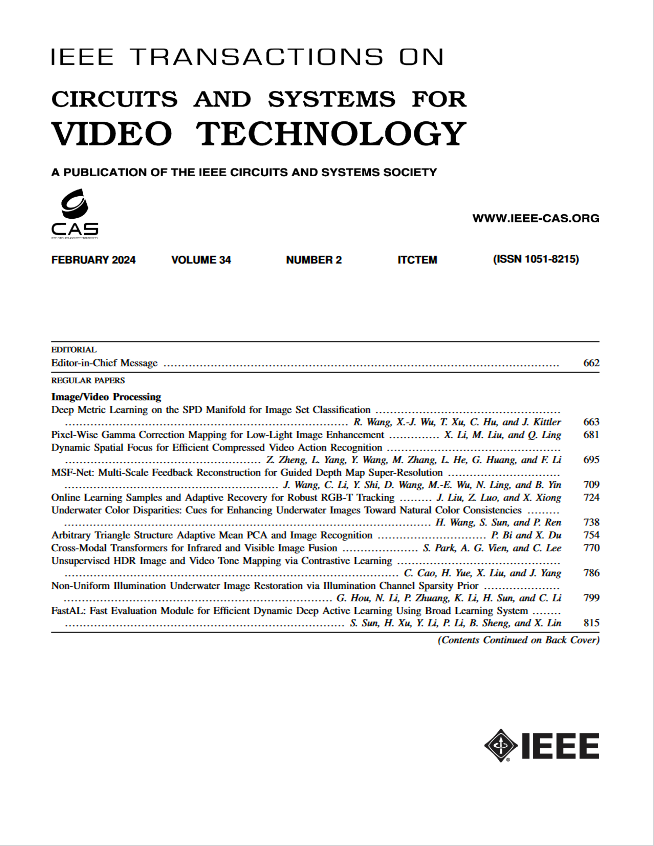基于运动增强的边缘引导网络的少镜头动作识别
IF 11.1
1区 工程技术
Q1 ENGINEERING, ELECTRICAL & ELECTRONIC
IEEE Transactions on Circuits and Systems for Video Technology
Pub Date : 2025-01-24
DOI:10.1109/TCSVT.2025.3533573
引用次数: 0
摘要
现有的多镜头动作识别(FSAR)方法通过空间和时间建模实现了较好的识别效果。然而,目前大多数方法忽略了边缘信息和运动线索的重要性,导致性能较差。对于少镜头任务,有效地探索有限的数据是很重要的。此外,有效地利用边缘信息有利于探索运动线索,反之亦然。在本文中,我们提出了一种新的边缘引导运动增强网络(EGME)。据我们所知,这是第一个利用边缘信息作为FSAR任务指导的工作。我们的EGME包含两个关键组件,包括边缘信息提取器(EIE)和运动增强模块(ME)。具体来说,eee用于获取视频帧的边缘信息。然后,利用边缘信息作为指导与帧特征融合。此外,ME可以自适应捕捉视频的动作敏感特征。它采用自门控机制,从大的时间感受野中突出视频中的运动敏感区域。基于上述设计的组件,EGME可以捕获边缘信息和运动线索,从而获得更好的识别性能。在四个具有挑战性的基准上的实验结果表明,EGME与最近的先进方法相比表现良好。本文章由计算机程序翻译,如有差异,请以英文原文为准。
Edge Guided Network With Motion Enhancement for Few-Shot Action Recognition
Existing state-of-the-art methods for few-shot action recognition (FSAR) achieve promising performance by spatial and temporal modeling. However, most current methods ignore the importance of edge information and motion cues, leading to inferior performance. For the few-shot task, it is important to effectively explore limited data. Additionally, effectively utilizing edge information is beneficial for exploring motion cues, and vice versa. In this paper, we propose a novel edge guided network with motion enhancement (EGME) for FSAR. To the best of our knowledge, this is the first work to utilize the edge information as guidance in the FSAR task. Our EGME contains two crucial components, including an edge information extractor (EIE) and a motion enhancement module (ME). Specifically, EIE is used to obtain edge information on video frames. Afterward, the edge information is used as guidance to fuse with the frame features. In addition, ME can adaptively capture motion-sensitive features of videos. It adopts a self-gating mechanism to highlight motion-sensitive regions in videos from a large temporal receptive field. Based on the above designed components, EGME can capture edge information and motion cues, resulting in superior recognition performance. Experimental results on four challenging benchmarks show that EGME performs favorably against recent advanced methods.
求助全文
通过发布文献求助,成功后即可免费获取论文全文。
去求助
来源期刊
CiteScore
13.80
自引率
27.40%
发文量
660
审稿时长
5 months
期刊介绍:
The IEEE Transactions on Circuits and Systems for Video Technology (TCSVT) is dedicated to covering all aspects of video technologies from a circuits and systems perspective. We encourage submissions of general, theoretical, and application-oriented papers related to image and video acquisition, representation, presentation, and display. Additionally, we welcome contributions in areas such as processing, filtering, and transforms; analysis and synthesis; learning and understanding; compression, transmission, communication, and networking; as well as storage, retrieval, indexing, and search. Furthermore, papers focusing on hardware and software design and implementation are highly valued. Join us in advancing the field of video technology through innovative research and insights.

 求助内容:
求助内容: 应助结果提醒方式:
应助结果提醒方式:


